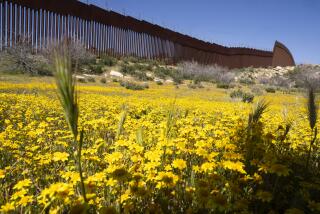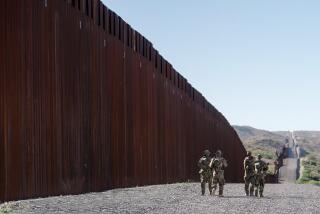Trash, Tourists Torture Peru’s Huge Pictographs
NAZCA, Peru — Standing inside the maze of mysterious lines and figures that put this arid region on the tourist map, state archeologist Alberto Urbano surveys a football field-sized spread of ankle-deep trash.
“Farther down this road, there are illegal gold mines too,” he said, noting that the path actually is the side of a giant trapezoid. “See how straight it is.”
But not just trash and small-time gold diggers threaten Peru’s fragile Nazca Lines. Grave robbers, tractor-trailers and tourists have left their mark on the mammoth designs carved more than a millennium ago along a 35-mile stretch of desert.
In many ways, the damage reflects Peru’s inability to protect its myriad pre-Columbian archeological gems.
Urbano blew the whistle on the municipality of Nazca in October for briefly dumping trash inside the 175-square-mile protected zone that has been a United Nations World Heritage site since 1994.
Three months earlier, highway officials had to move a weighing station 10 miles north of the zone to stop cargo trucks from cutting across the lines to avoid paying tolls.
Located 250 miles south of Lima, the lines have puzzled scientists, drawn mystics and even inspired an eccentric German mathematician to devote the last five decades of her life to studying and protecting them. Each year, about 80,000 tourists fly over the pictographs.
But loosely guarded by day, the site is wide open by night.
Since mathematician Maria Reich died in 1998 at age 95, watching over the site has fallen upon a handful of men she once employed -- and Urbano, the lone state archeologist.
Reich’s remaining guards finance their operations by charging tourists 6 nuevo soles, or less than $2, to climb up a metal observation tower beside the Pan-American Highway, which itself cuts through the site -- and an unlucky lizard figure.
The squad rides an old motorcycle that is on its last legs to patrol parts of the zone. Urbano gets by on a monthly salary of about $515 from Peru’s National Institute of Culture and uses his bicycle or hitches rides to get around.
Nazca Mayor Daniel Mantilla wants the municipality to take over caring for the site. He says he was forced to drop trash in the protected zone because the culture institute failed to approve a site for a new dump.
“The lines are in danger,” he said. “The government must decide who should protect them.”
The mayor’s comments reflect a broader problem, with the underfunded and overextended culture institute butting heads with town officials nationwide.
Meanwhile, the United Nations has criticized the agency for failing to take care of several of Peru’s 10 World Heritage sites.
In October, it said the institute needed to curb damage from heavy tourist traffic at the Inca citadel of Machu Picchu and bring order to development nearby in Peru’s jungle-covered southern Andes.
On Peru’s Pacific coast, shantytowns spreading out from the nearby city of Trujillo threaten to overrun parts of Chan Chan, considered the largest adobe city in the Americas.
In Nazca, Italian archeologist Giuseppe Orefici, who has been studying the Nazca culture for 22 years, believes that damage is extensive.
“There are thousands of other hieroglyphics that aren’t off-limits -- and they are being destroyed rapidly,” he said.
Orefici is not alone in his concern.
Congressman Luis Gonzales Posada, whose district includes Nazca, wants the United Nations to expand the World Heritage site to protect lesser known lines in Palpa, just north of the Nazca Lines.
The lawmaker has asked Peru’s air force to take new color aerial photographs of the region to catalog the extent of damage. The black-and-white images now in use were taken three decades ago.
No one knows why the pre-Inca Nazca culture made the lines -- some of them miles long -- by clearing dark surface rocks to expose powdery white sand underneath.
Among theories, the lines may have served as a calendar or a map of underground water systems. Some people have even speculated that they were landing strips for spacecraft.
Although some of the lines can be seen from the ground, the huge pictographs can only be seen clearly from the air. Up to 900 feet in length, they include a spiral-tailed monkey, a soaring condor and what some people see as a bubble-headed spaceman.
The lines are virtually frozen in time by the nearly static climate of one of the world’s driest deserts. So is the damage that befalls them.
Between the dog and the monkey figures, a white crater marks the crash site of two sightseeing planes that collided in 1997. A lonely pair of tire tracks records the path that rescue vehicles took to recover the wreckage.
“Those lines will be there for centuries,” pilot Angel Segura said.
More to Read
Sign up for Essential California
The most important California stories and recommendations in your inbox every morning.
You may occasionally receive promotional content from the Los Angeles Times.










